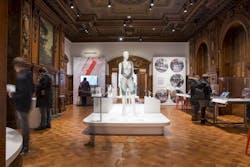Universal Design in the Age of Accessibility
Cara McCarty remembers the undeniable ergonomic design of the iconic Fiskars orange-handled scissors, when they were released by the Finnish consumer goods company in the late ‘60s and early ‘70s, long before universal design.
Now, as the curatorial director for the Cooper Hewitt Smithsonian Design Museum in New York, McCarty oversees the museum’s collections and helps shape the exhibition program. During Helsinki Design Week, she spoke of the importance of universal design – something those orange-handled scissors still possess.
Access+Ability Broadens Design
McCarty helped curate the exhibition Access+Ability, which wrapped up its run at Cooper Hewitt in early September. The show explored the “surge of design with and by people with a wide range of physical, cognitive and sensory abilities.” It featured more than 70 innovative designs developed in the last decade, such as a necklace and bracelet that double as a wearable navigation system for people who are blind. Another featured item was a patterned, colored prosthetic leg cover with the goal of giving amputees the ability to shop for different looks like they would for clothes.
In a separate interview during Helsinki Design Week, McCarty praises Finnish designers and their processes for focusing on accessibility.
Read this next: Ergonomic Flooring Installation Remedies New Neuro ICU
“The user is central to Finnish design,” she says. “It’s just part of their DNA, an emphasis on function and making their products available to everyone. [Some brands], they have it in their city apartments and their summer cottages. I’ve felt it’s part of their mentality here.”
Although McCarty feels the U.S. is behind in universal design, she believes it’s becoming less of an afterthought – especially after working on Access+Ability.
Universal Design: More than an Afterthought
“There’s so many opportunities out there for better design,” she says. “I’m inspired by young designers today who are really embracing that. They really want to make a positive difference in the world. That was one of the really hopeful things about that exhibition.”
Cost can be a major deterrent when it comes to accessible design in the U.S., with customers more prone to looking at the short-term rather than long-term investment, McCarty explains. “The return on solar power took so long to take hold,” she says. “Now people are saying we can make ourselves much more self-sustaining. It’s just changing our processes and our whole system of processing materials.”
McCarty expects to see more of a focus on smart interiors and universal design in the near future, with such features as glass surfaces with embedded digital components and customizable lighting – and, we hope, still a pair of those iconic orange scissors.
Listen now to I Hear Design: The interiors+sources Podcast



